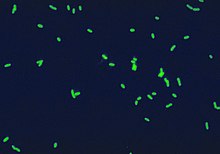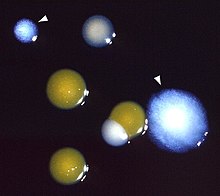Legionella pneumophila
| Legionella pneumophila | ||||||||||||
|---|---|---|---|---|---|---|---|---|---|---|---|---|

Legionella pneumophila in a pulmonary fibroblast |
||||||||||||
| Systematics | ||||||||||||
|
||||||||||||
| Scientific name | ||||||||||||
| Legionella pneumophila | ||||||||||||
| Brenner et al. 1979 |
Legionella pneumophila is a gram-negative, unencapsulated and spore-free rod bacterium. It is the cause of Legionnaires' disease and Pontiac fever . The most important (human pathogenic) serotypes of Legionella pneumophilafor humansare serotypes 1 (70 to 80 percent of all legionnaires in humans), 4 and 6.
Microbiological properties
Legionella pneumophila is an obligatory aerobic , gram-negative rod with mostly monopolar flagellation . In the native preparation, mostly short rods are found, while rod bacteria of different sizes (2–20 µm) predominate in culture. Legionella mainly use amino acids as an energy source. Sugars cannot be metabolized into acids. Legionella depend on cysteine and iron (III) ions in the nutrient medium. Therefore, they are usually found in the wild in combination with autotrophic microorganisms (e.g. iron-manganese bacteria) or they are found in amoebas ( e.g. Acanthamoeba , Naegleria ). Amoebas appear to play an important role in the spread of Legionella pneumophila. Legionella do not form urease and nitrase , but are catalase positive. Legionella are sensitive to dehydration. At a temperature of 60 ° C, they survive for about five minutes.
Legionella pneumophila forms biofilms with a density of up to 100,000 cfu / cm 2 . The biofilm protects the bacteria from biocides or harsh environmental conditions.
Spread
Legionella pneumophila is found worldwide in soil and water samples. As a source of infection for humans, it can be found in hot water pipes with insufficiently heated water (<60 ° C), air conditioning systems and cooling towers.
frequency
Legionnaires usually occur sporadically, less often in small epidemics . In the United States, it is estimated that around 30 cases occur per year for every 100,000 population. The legionnaires have a peak in the summer months. In endemic areas, it is estimated that around 5% of pneumonia can be traced back to Legionella. For Germany, it is estimated that almost 4% of all outpatient pneumonia can be traced back to Legionella.
Diseases
The Legionnaires' disease is an atypical, interstitial pneumonia with fever , diarrhea , headaches and disorientation. It often affects immunocompromised people (e.g. alcoholics, people with HIV).
The Pontiac fever is an acute, self-limited respiratory illness with cough and colds, which heals spontaneously usually after seven days.
transmission
The transmission is usually airborne, mostly by inhaling aerosols containing pathogens from air conditioning systems or water taps. It is estimated that only 10% of infections actually lead to disease. There is no person-to-person transmission.
incubation period
The incubation period for Legionnaires' disease is two to ten days, but that of Pontiac fever is only one to two days.
Pathogenesis
Legionella pneumophila adheres to host cells via a pilus and induces a special form of phagocytosis (so-called coiling phagocytosis ), but escapes intracellular destruction and multiplies in non-activated phagocytic cells. Legionella pneumophila induces a partially necrotizing inflammation of the alveoli . The defense against Legionella pneumophila as an intracellular pathogen is probably dependent on T lymphocytes . These activate the macrophages containing the pathogen so that the pathogens inside the phagocytes can be destroyed. Legionella pneumophila produces exotoxins (such as hemolysin ) and enzymes . The role of these exotoxins in the disease process has not yet been conclusively clarified. The protein MIP (macrophage infectivity potentiator), a 24 kDA protein, appears to be involved in the induction of phagocytosis.
therapy
Legionnaires' disease is usually treated with macrolides ( e.g. erythromycin ) in combination with rifampicin or a fluoroquinolone . The pathogen detection is notifiable according to § 7 of the Infection Protection Act.
Diagnosis
- Antigen Detection : A Legionella pneumophila - antigen detection can be carried out in the urine ( ELISA ) and is the recommended guideline according diagnostic method of choice in cases of suspected Legionella infection.
- Microscopy : Legionella is difficult to stain with the Gram stain. Therefore, fluorescence- labeled monoclonal antibodies are mostly used .
- Cultivation : The cultivation can be achieved from lung biopsies , bronchial secretions and a broncho-alveolar lavage . It is important that you inform the laboratory of the suspected diagnosis of legionnaires' disease, as the pathogen cannot be attracted to routine culture media. It can be grown on buffered charcoal yeast agar with the addition of alpha-ketoglutarate (alpha BCYE agar). Colonies appear after two to seven days with capnophilic incubation.
- PCR : PCR enables pathogens to be detected quickly from samples such as bronchoalveolar lavage, lung tissue, tracheal secretions and sputum, but not from urine. The sensitivity is very high, the results are partly better than with culture methods.
- Serology : Antibodies against L. pneumophila can be detected in the blood after about ten days.
Historical
Legionella pneumophila was not discovered until 1976 when an epidemic emerged among participating veterans at a meeting of the American Legion in Philadelphia. 29 of the 182 sick veterans died at the time. It was then that Legionnaires' disease got its name.
literature
- Marianne Abele-Horn: Antimicrobial Therapy. Decision support for the treatment and prophylaxis of infectious diseases. With the collaboration of Werner Heinz, Hartwig Klinker, Johann Schurz and August Stich, 2nd, revised and expanded edition. Peter Wiehl, Marburg 2009, ISBN 978-3-927219-14-4 , p. 206 f.
Web links
- RKI-Ratgeber: Legionellosis Published: Epidemiological Bulletin 8/2013
- European Legionnaires' Disease Surveillance Network (ELDSNet)
Individual evidence
- ↑ Yusen Lin: Legionella in Water Systems . In: The science and technology of industrial water treatment . CRC Press, Boca Raton, FL 2010, ISBN 978-1-4200-7145-0 , p. 414.
- ^ Legionnaires' disease in 2011 . In: Epidemiological Bulletin . No. 50 , 2012, p. 501 ( online [PDF]).
- ↑ S3 guidelines on epidemiology, diagnostics, antimicrobial therapy and management of adult patients with community-acquired deep respiratory infections. Short version. 2nd edition, 2009. ISBN 978-3-13-133712-2 . ( pdf 501 kB online at capnetz.de)
- ^ RKI guide for doctors. Legionnaires. Updated February 2013 . In: Epidemiological Bulletin . No. 8 , 2013, p. 61–67 ( online [PDF]).
- ↑ Lawrence K. Altman: In Philadelphia 30 Years Ago, an Eruption of Illness and Fear. The New York Times, August 1, 2006, accessed January 10, 2015 .


